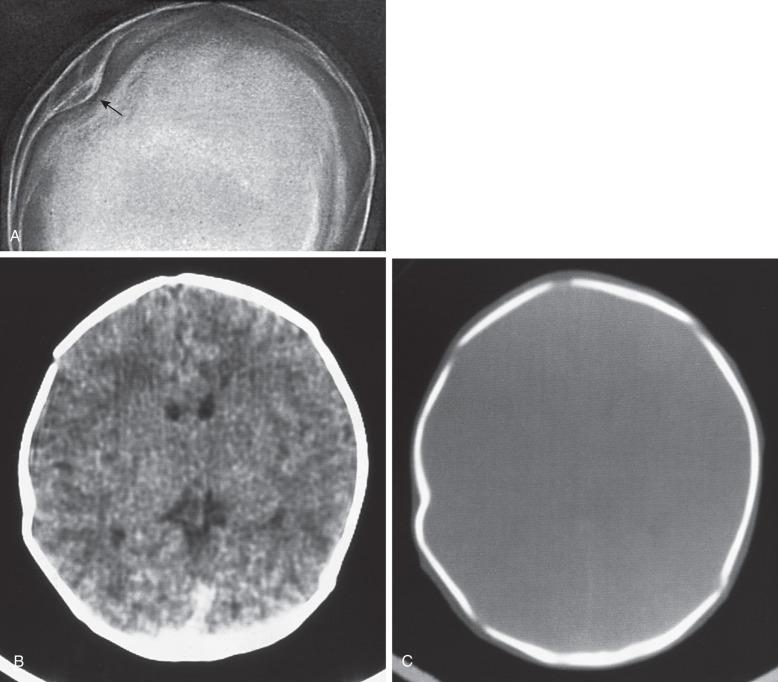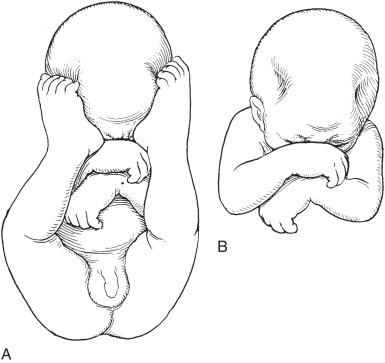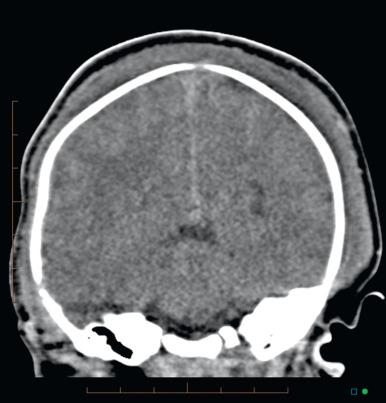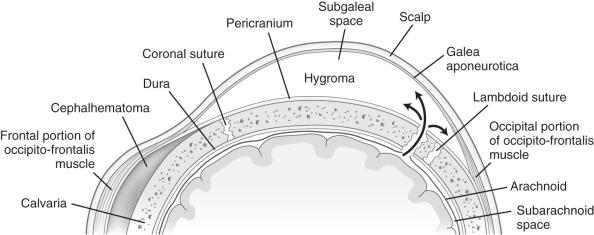Physical Address
304 North Cardinal St.
Dorchester Center, MA 02124
Congenital depressions of the calvaria result from mechanical factors that occur before or during birth. During labor, calvarial depressions are caused by excessive localized pressure on the head by the bony prominences in the maternal pelvis, including the sacral promontory, pubic symphysis, and sciatic spines ( e-Fig. 23.1 ). Application of forceps to the fetal head and traction with excessive force is another less common cause of congenital depressions.

Deformities also may develop from sustained abnormal fetal positions ( e-Fig. 23.2 ). Grooves in the calvarium and face may be caused by excessive pressure of an ectopic limb and represent restrictions of the usual active movements of the fetus. Deformities also may arise as a result of pressure from amniotic bands. Depressions due to long-standing fetal position are present at birth and are not associated with edema or hemorrhage.

These calvarial depressions are usually visible by direct inspection, but radiographs often are obtained to search for associated fractures. Spontaneous elevation of prenatal depressions during the first year after birth without adverse residual effects have been reported. Acute depressions as a result of the application of forceps, often called “ping-pong ball depressions,” have been elevated by simple tangential digital pressure on opposite sides of the depression and by suction with a vacuum extractor.
Hemorrhage in the neonatal scalp has an increased incidence with difficult or traumatic deliveries. It may occur at three different levels: subcutaneous (caput succedaneum), subaponeurotic (subgaleal), and subperiosteal (cephalhematoma). More superficial bleeds cross suture lines and may extend widely into the face ventrally, onto the neck dorsally, and onto the zygomatic arches and mastoid processes laterally.
Caput succedaneum is a local subcutaneous swelling of the scalp that contains edema and blood and can extend across suture lines ( Fig. 23.3 ). It is usually a result of pressure on the presenting head. The swelling is recognized at birth and disappears after a few days. Local scalp swelling casts a shadow of water density on skull radiographs that disappears without residual bone changes. Rarely, the hemorrhage can be so massive that hypovolemic shock occurs. In such cases, intracranial hemorrhage often is present.

Subgaleal hemorrhages, also known as cephalhematoceles, result from an accumulation of cerebrospinal fluid (CSF) and blood beneath the epicranial aponeurosis caused by the rupture of emissary veins. The abnormal fluid extends across the sutures into a potential space that can develop slowly postdelivery. Clinically, they present as a fluctuant mass and may simulate a cephalhematoma or caput succedaneum. Radiographically, the swellings are usually in the parietal regions and can have associated fractures ( Fig. 23.4 ). Trauma from use of obstetric forceps or vacuum extraction is a common cause of subgaleal hematomas. In older children, a subgaleal hygroma may result from hair-pulling in cases of child abuse or accidental entrapment of long hair in mechanical equipment. A subgaleal hematoma may occur without trauma in patients with coagulation abnormalities.

Become a Clinical Tree membership for Full access and enjoy Unlimited articles
If you are a member. Log in here